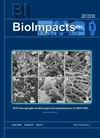利用聚己内酯/明胶电纺纳米纤维中的脂肪间充质干细胞和纳米锰颗粒促进大鼠烧伤创面愈合
IF 2.2
4区 工程技术
Q3 PHARMACOLOGY & PHARMACY
引用次数: 0
摘要
导言:伤口愈合是再生医学的一个主要治疗问题。本研究旨在利用聚己内酯/明胶电纺纳米纤维支架中的大鼠脂肪衍生干细胞(ADSCs)和锰纳米颗粒(MnO2-NPs)治疗大鼠二度烧伤创面。研究方法在合成纳米粒子和电纺纳米纤维后,进行了扫描电镜分析、接触角、机械强度、血液相容性、孔隙率、溶胀性、生物降解性、细胞活力和粘附性检测。结果表明,PCL/凝胶/5%MnO2-NPs 纳米纤维(Mn-5%)是最适合的支架。ADSCs 种子 Mn-5% 支架被用作烧伤创面敷料。测定了创面愈合率、IL-1β和IL-6水平、羟脯氨酸和糖胺聚糖含量,并进行了苏木精和伊红、Masson三色染色和免疫组化染色。结果结果显示,与对照组相比,Mn+S(ADSCs+PCL/凝胶/5%MnO2-NPs纳米纤维)组和N+S(ADSCs+PCL/凝胶纳米纤维)组的IL-6和IL-1β水平降低,伤口闭合率、糖胺聚糖和羟脯氨酸含量增加(P<0.05)。此外,在这两组中观察到的α-SMA量最低,这表明干细胞在降低α-SMA水平从而防止纤维化方面发挥了作用。此外,Mn+S组的α-SMA含量低于N+S组,更接近健康皮肤。根据组织学结果,Mn+S 组的治疗效果最佳。结论总之,ADSCs Seed PCL/Gel/5%MnO2-NPs支架在烧伤创面愈合中表现出了相当大的治疗效果。本文章由计算机程序翻译,如有差异,请以英文原文为准。
Burn wound healing using adipose-derived mesenchymal stem cells and manganese nanoparticles in polycaprolactone/gelatin electrospun nanofibers in rats
Introduction: Wound healing is a major therapeutic concern in regenerative medicine. The current study aimed to investigate the second-degree burn wound treatment in rats using rat adipose- derived stem cells (ADSCs) and manganese nanoparticles (MnO2–NPs) in a polycaprolactone/gelatin electrospun nanofiber scaffold. Methods: After the synthesis of nanoparticles and electrospinning of nanofibers, the SEM analysis, contact angle, mechanical strength, blood compatibility, porosity, swelling, biodegradability, cell viability, and adhesion assays were performed. According to the results, the PCL/Gel/5%MnO2-NPs nanofiber (Mn-5%) was determined to be the most suitable scaffold. The ADSCs-seeded Mn-5% scaffolds were applied as a burn wound dressing. The wound closure rate, IL-1β, and IL-6 level, hydroxyproline, and glycosaminoglycans content were measured, and the hematoxylin and eosin, Masson’s trichrome, and immunohistochemistry stainings were carried out. Results: Based on the results, in Mn+S (ADSCs+PCL/Gel/5%MnO2-NPs nanofiber) and N+S (ADSCs+PCL/Gel nanofiber) groups, the IL-6 and IL-1β levels were reduced, and the percentage of wound closure, glycosaminoglycans, and hydroxyproline content were increased compared to the control group (P<0.05). Also, the lowest amount of α-SMA was observed in these two groups, demonstrating stem cells' role in reducing α-SMA levels and thus preventing fibrosis. Moreover, the amount of α-SMA in the Mn+S group is lower than in the N+S group and, is closer to healthy skin. According to histology results, the best type of treatment was observed in the Mn+S group. Conclusion: In conclusion, the ADSCs-seeded PCL/Gel/5%MnO2-NPs scaffold demonstrated considerable therapeutic effects in burn wound healing.
求助全文
通过发布文献求助,成功后即可免费获取论文全文。
去求助
来源期刊

Bioimpacts
Pharmacology, Toxicology and Pharmaceutics-Pharmaceutical Science
CiteScore
4.80
自引率
7.70%
发文量
36
审稿时长
5 weeks
期刊介绍:
BioImpacts (BI) is a peer-reviewed multidisciplinary international journal, covering original research articles, reviews, commentaries, hypotheses, methodologies, and visions/reflections dealing with all aspects of biological and biomedical researches at molecular, cellular, functional and translational dimensions.
 求助内容:
求助内容: 应助结果提醒方式:
应助结果提醒方式:


